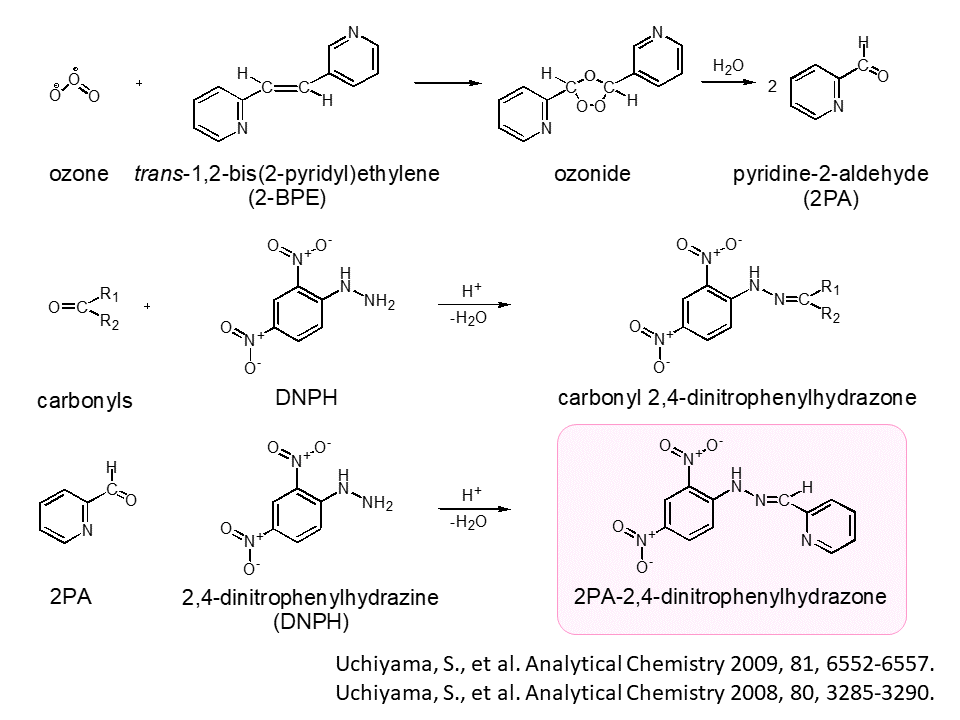
Create a safe and
healthy environment
1. Environmental pollution
2. Tobacco research
3. Derivatization analysis

In order to reduce the concentration of hazardous air pollutants in the environment and to create a comfortable and safe living space, it is important to reduce risks by chemical substances (risk assessment, risk management). Also, for risk assessment, it is necessary to accurately measure the averaged concentration in indoor and outdoor environments.
Our laboratory mainly develops the sampling devices and analytical methods for chemical compounds. Sampling devices developed by our research are sold all over the world and are applied for various research.
At the present time, we are investigating air pollution in Myanmar using these samplers in collaboration with University of Medicine 1, Yangon (Myanmar).
The potential health effect, induced by exposure to chemical compounds in ambient air for long periods, is an important problem. We have investigated a long-term monitoring method for measurement of chemical compounds in ambient air. Long-term, nonstop sampling periods of every 1-week were evaluated using four kinds of diffusive samplers.
Currently, we have been developing diffusive samplers that can collect for a long time, and we are continuously monitoring the seasonal variations for various chemical compounds. We have been also developing analytical methods for unregulated and unknown harmful compounds, and a personal sampler for personal exposure measurement.

2. Tobacco research
WHO reported that the tobacco epidemic is one of the biggest public health threats the world has ever faced, killing more than 7 million people a year. More than 6 million of those deaths are the result of direct tobacco use while around 890 000 are the result of non-smokers being exposed to second-hand smoke.
As a member of the World Health Organization (WHO) Tobacco Research WHO Tobacco Laboratory Network (TobLabNet), our laboratory have been developed the methods for measurement of chemical compounds generated from cigarettes. A part of the results were adopted by WHO's SOP (Standard Operating Procedure).
Recently, heated tobacco products such as iQOS, glo, PloomTECH, and electronic cigarettes are rapidly spreading, we have developed a new analytical method for chemical compounds generated from these products and reported the results.
Chem. Res. Toxicol. 2018, 31, 585-593.

We have developed a GF-CX572 followed by two-phase elution method. By applying the proposed GF-CX572 to the analysis of the mainstream smoke generated from heated tobacco products (HTPs) and traditional cigarettes, several chemical compounds are detected, and the chemical composition of smoke is revealed. The GF-CX572 one-cartridge method can analyze gaseous and particulate chemical compounds from the HTP smoke by utilizing not only the entire puff volume but also one puff volume because the GF-CX-572 cartridge can be replaced with a new cartridge within 3 s. An overview of the chemicals generated from HTPs is obtained in detail by one-puff volume sampling. In addition, the generated chemical compounds strongly depend on the temperature of tobacco leaves in HTPs.

As a substitute for traditional cigarette, firstly, electronic cigarettes (E-cigarettes) were sold. E-cigarettes are tobacco-like products that allow one to smoke aerosol by heating a solution of “E-liquid” that typically consists of propylene glycol and glycerol with Nichrome wire.
In our laboratory, propylene glycol and glycerol used for E-liquid are oxidized by heating, and aldehydes such as formaldehyde and acetaldehyde, as well as oxides such as propylene oxide and glycidol are produced. As these substances are carcinogenic, we should be watchful about the use of E-cigarettes.
.

3. Derivatization analysis
There are many highly reactive and unstable chemical compounds in ambient air. Analysis of these compounds is very difficult, because these compounds are easy to decompose. Derivatization analysis is a method of using chemical reactions to analyze unstable compounds as stable derivatives.
I have found various derivatives reactions for many years and have been studying the derivatization method of 2,4-dinitrophenylhydrazine (DNPH). The figure on the right shows the reaction when derivatizing ozone, which is easy to decompose, into pyridine aldehyde and simultaneously detecting coexisting carbonyl compounds. We have gotten quite a lot of knowledge such as isomerization reaction, reaction with carboxylic acid, reductive amination of hydrazone derivative, and we are currently studying new derivatization reaction.

